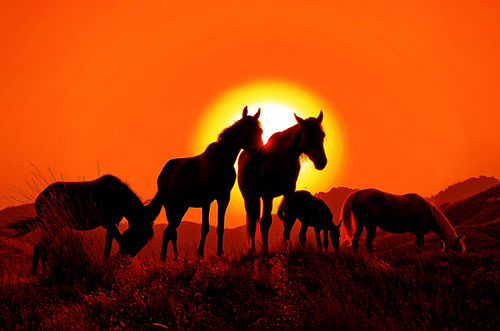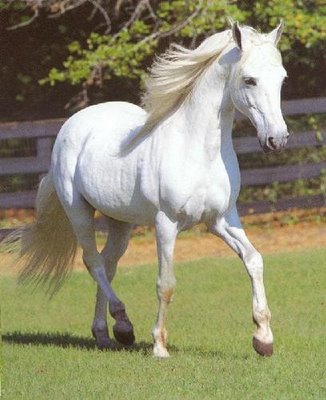Horse – large solid-hoofed herbivorous ungulate mammal (Equus caballus, family Equidae, the horse family) domesticated since prehistoric times and used as a beast of burden, a draft animal, or for riding

Horse – large solid-hoofed herbivorous ungulate mammal (Equus caballus, family Equidae, the horse family) domesticated since prehistoric times and used as a beast of burden, a draft animal, or for riding

Spirit of the Horse is full of beautiful horse photos. It has several chapters including; Wild Horses, Draft Horses, Ponies, and Foals. In addition to the many photos it also has many interesting horse facts written in paragraph format. Spirit of the Horse is a treasure any horse lover should be glad to put on their shelf.

I looked at the empty screen. What could I do a post about? Normally I have tons of ideas but today my inkwell was all dried up. So I did the only thing I could – went looking for a great post that I could copy and give credit to the author. After hours (it seemed) of fruitless searching, I stumbled across this blog. The very first post I saw, I wanted on my blog, so here it is.
**********************************************************************************************************
When I was a kid I was very familiar with the Godolphin Arabian, thanks to Marguerite Henry’s, King of the Wind. Ms. Henry took a lot of liberties with the story, but I’ll address that another time. It’s still one of my favorite children’s books and I think it’s a good way to spark a child’s interest in horse history.
Occasionally I would see the Godolphin Arabian referred to in history as the “Godolphin Barb,” so I assumed that Arabians and Barbs were similar types of horses. This is actually far from the truth.
So what is the difference between an Arab and a Barb? And why is the Godolphin Arabian sometimes called a Barb?
Most people can quickly identify an Arabian by it’s more refined build, usually dished profile and wedge-shaped head, and high-set, flagging tail. It’s also consistently in the top five most popular breeds in the U.S., so it’s not hard to find an example. The Arabian originates from Mesopotamia along the Tigris-Euphrates Rivers just north of the Arabian Desert, where it began as an ancient Afro-Turkic horse that was specialized by Bedouin warriors. The Arabian became a horse that could run mostly straight, long distances over desert ground.
So if Arabians and Barbs are so different, why is the Godolphin Arabian sometimes called a Barb?
The Godolphin Arabian’s origins are not known for certain, but it’s believed he was a gift from the first Bey of Tunis, or King of Tunisia, to the King of France in 1729. Because Tunisia is located in North Africa along the Barbary Coast, which was well-known for its Barb warrior horses, it was mistakenly believed that the Godolphin Arabian was a Barb — but he wasn’t. Descriptions of the Godolphin Arabian from the time show that he was about the size of an average modern Arabian (between 14.2 and 15 hands) with a light build, fiery temperament, and high set, flagging tail.
The Godolphin Arabian went on to sire a racing dynasty in England, but that’s a story for another day.
While not as well-known to the public, the Barb has been as influential upon other horse breeds as the Arabian. Its descendants include the Andalusian and Lusitania, and through the historical Spanish Jennet, the Barb is ancestral to the South American Criollo, Paso horses, American mustang, and Quarter Horses and their related breeds.
*******************************************************************************************************
This post perfectly displays all the details between Barb’s and Arab’s and I’m glad to post it on my blog. Check out the original post here.

Shire horses were introduced in 1145. They were used to pull plows like oxen. Then during the reign of Henry VIII, Shire horses were used in battle as war horses. The introduction of gunpowder removed horses from the field of battle.
Shires were first called Old English Black Horses. The name ‘Shire’ was introduced in the mid 17th century. In 1878 the Old English Black Horse Society was formed, but it was renamed the Shire Horse Society in 1884. When WWII came the Shire horse was slaughtered in great numbers for food. Less then 100 of them were still alive. Then, in the 1970’s people became more interested in the Shire then ever, and their numbers have grown to 2,000 which still makes the breed ‘at risk.’
Shire horses range from black to grey to brown. They can also be roan or bay. Stallions must stand at least 17 or 17.2 hands (4 inches to a hand) tall, and mares and geldings 16 hands. Shires have short muscular backs and broad hooves. Unlike other draft breeds, they have less ‘feathering’ around the hooves.



 Find out more info about the Shire horse here.
Find out more info about the Shire horse here.
I just created a horse club. You can join it by going here. I hope you like it a lot. Have fun!
